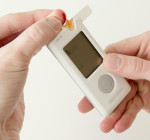One important factor in managing your diabetes is controlling your glycemia and the rate of absorption of glucose into your bloodstream. It can be achieved by pre-loading your meal with fat and proteins.
Many studies have shown that both fat and proteins have several beneficial effects on glucose management, especially in the context of type 2 diabetes: they can delay gastric emptying, therefore delaying the glucose spike and they can coat the intestine to slow down absorption of glucose. Fat being the most beneficial.
Of course, the clinical tests have been mostly performed drinking diluted fat or proteins before a meal, which isn’t appetising. So what can you do? The first thing you can do is order your meals right. It’s common nowadays to not eat starters and just eat the main dish of a meal. Time constraints, and smaller meals push in that direction. But with diabetes, that’s a mistake. If you start your meal with your main dish, usually loaded with carbs, you dump all your carbs straight into your stomach that will work hard at preparing the food for your intestine and it results in a fast absorption of glucose. Therefore a fast and high glucose spike.
On the contrary, if you first eat vegetables, like is traditional, with a fatty and vinegary seasoning, as is also traditional, you’ll prepare your digestive system by pre-loading it with something that has been shown delays gastric emptying, and therefore delays the glucose spike. With the addition of the vegetable‘s fiber, you get the most protection from glucose.
An alternative is to eat eggs or soy milk before your main dish. Though remember that animal proteins aren’t good to diabetics.
One question I had when I learned about fat and protein pre-loading was: how long before the carbs do you need to pre-load? It seems that eating fat and proteins before the carb, even not long before, works. Therefore a normal starters then mains sequence is fine. In fact, even coingestion (eating fat and proteins at the same time as carbs) has been shown to be effective (though in that case there was no diminution of insulin, so it’s probably less beneficial for insulino-resistants). In most cases, I tried to first eat vegetables, then eat carbs. When I had to eat carbs, obviously, I usually prefer to avoid them completely for a high fiber low carb diet, and our meal consists mostly of the salad itself.
If you want to be convinced, experiment: eat the same meal on different days, once with a veggie starter, once without, and monitor your glycemia closely after the meal.



